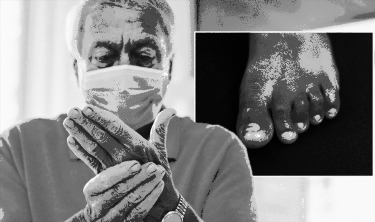China: Shanghai sees protests against Covid-19 lockdown
We use your sign-up to provide content in ways you’ve consented to and to improve our understanding of you. This may include adverts from us and 3rd parties based on our understanding. You can unsubscribe at any time. More info
While a lot of the effects of COVID-19 are felt on internal organs, on the lungs and heart, the effects of Covid can also be seen on the outside, on the skin.
Some individuals have experienced a phenomenon known as “Covid digits”.
The NHS describes these as “tender swellings on the fingers and toes which may be purple in those with lighter skin or a slightly darker appearance/brown/black in those with darker skin”.
The NHS says: “They usually appear sometime after the onset of the infection and may last up for more than 12 weeks.”

Furthermore, “The areas heal slowly after Covid has gone away, with peeling of the skin”, adds the health provider.
This isn’t the first time Covid’s impact on the skin has been noted.
Earlier in the pandemic some patients noticed changes in their skin during or after infection with COVID-19.
Furthermore, research is ongoing to establish if different variants of the virus cause different skin afflictions.
Researchers from the King’s College London ZOE Covid study say: “King’s is currently working on analysing skin symptoms as a key indicator for new variants.
“For example, many people with the early Alpha variant documented symptoms of Covid toes or a chicken pox-like rash.”
Covid digits aren’t the only way in Covid affects the skin; other symptoms have been experienced too.
This includes, says the NHS: “A very itchy widespread rash with tiny lumps and blisters like prickly heat.”

The rash in question is known as urticaria.
Also known as a nettle-rash it can appear suddenly on the skin and come and go quickly over a matter of hours.
The NHS notes: “This can come up early in the Covid infection but can last for months afterwards.
“Antihistamine tablets from a chemist can help with the itch. If the rash affects the face, causing swelling of the lips or tongue, then advice from NHS 111 should be sought.”

Another skin issue that can occur is called pityriasis rosea; this appears on the abdomen and starts with a red patch followed by red or darker patches.
With several of these conditions, moisturisers can help alleviate the discomfort.
The NHS warns two rashes that can occur after Covid require urgent medication attention.
These include a viral widespread rash called PIMS (paediatric inflammatory multisystem syndrome) and purple, tender lumpy areas on the skin called purpura.
Source: Read Full Article
